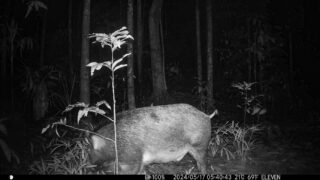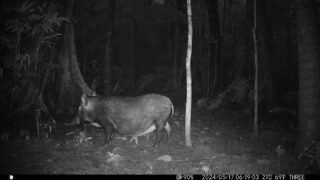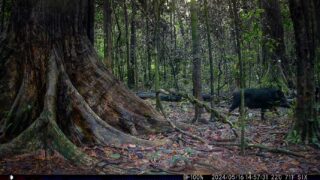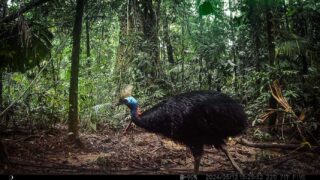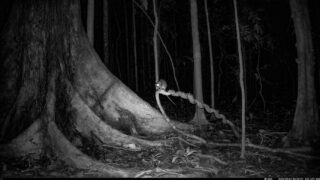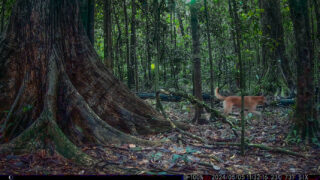Camera Traps – May 2024 accrued only 9-cassowary sightings, 38-dingoes and 92-feral pigs. Against the cumulative monthly average, cassowary numbers dropped by 91%, dingoes stooped by 3% and feral-pig numbers fell by 41%. Against May 2023, cassowaries were 90% fewer, dingo numbers dropped by 20% and feral-pigs also fell by 40%.
This relentlessly wet year has played havoc with the cameras and all statistics are well down for technical failings. Also, with the loss of four chicks in the floods pursuant to Tropical Cyclone Jasper, two and possibly three males are incubating eggs and not walking in front of camera-traps.
Image highlights from May 2024
More feral-pigs on the way …
Giant White-tailed Rat – Uromys caudimaculatus
Another sighting of the undescribed species of green huntsman spider
Magnificently discrete, in translucent conformity with the green underside of their leafy habitat, the only way to systematically find one is to look deliberately for the tiny glimmer of eye-shine that betrays their otherwise highly-evolved concealment.
Jabalbina Green Economy Workshop
Jabalbina Yalanji Aboriginal Corporation and the Wet Tropics Management Authority convened the Jabalbina Green Economy Workshop at James Cook University’s Daintree Rainforest Observatory, on 30th & 31st May 2024. This workshop intended to build upon the 2023 Daintree Restoration Field Day, where Eastern Kuku Yalanji Elders, restoration groups and community members met to discuss how conservation practices can evolve through greater collaboration to create economic opportunities for First Nations peoples. The workshop also sought feedback and support for a draft Jabalbina Green Economy Strategy that aims to build sustainable prosperity for Eastern Kuku Yalanji Bama (people) and the region, through an integrated conservation and development model of rainforest restoration and return to live on country.
Environmental charities from as far away as NSW & Brisbane and one local charity, Climate Force were all invited, but Daintree Rainforest Foundation LTD was not, leaving directors bemused by their organisation’s apparent unworthiness. In stark contrast with the majority of charities campaigning to ‘Save the Daintree Rainforest’ from thousands of kilometres away, Daintree Rainforest Foundation LTD operates exclusively within the Daintree World Heritage environment and constitutionally must perform its functions in a way that is consistent with the protection of inhabitant people, who are not only constituent parts of the legislated definition of ‘environment’, they are also its sole caretakers and exclusive repository of local knowledge. Also, in performing its functions, the Foundation must, as far as practicable, liaise, cooperate with and have regard to the traditions of the indigenous people particularly concerned with the Land.
Of even greater value and relevance, Daintree Rainforest P/L has been sustaining genuine ecotourism cost-recovery from Daintree World Heritage Rainforest management, over the past three-decades, with the opposite of government support and despite having more to offer Kuku Yalanji repatriants in real world experience than any other agency, it was also not invited, neither by ‘partners-in-protection’ – the Wet Tropics Management Authority (WTMA), nor Jabalbina Yalanji Aboriginal Corporation. If it had been included, this would have been its advice:
Rehabilitation is an environmental management requirement of the Wet Tropics World Heritage Area’sprimary goal. The forced removal of Kuku Yalanji custodial inhabitants, ninety-years before World Heritage-listing, has left a terrible legacy of neglect, which, amongst other consequences, has allowed for the pestilent proliferation of feral-pigs. Restitution of Kuku Yalanji custodians would allow for that key threatening process to be mitigated in the longer term and it would also conform with the expectations of discerning international ecotourism interests. Indeed, an ecotourism destination boasting the solitary coincidence of two adjoining World Heritage properties, cannot possibly hope to achieve world’s best-practice without providing members of the traditional Indigenous community with restored inhabitancy and custodianship.
In the Daintree Rainforest, where environmental sensitivities are about as valuable as they get, a magnificent ecotourism property closed its doors to business over a dozen years ago. If both the current owner and also Kuku Yalanji interests were amenable, an existing footprint of approved development retains outstanding repatriation potential. Surrounded by World Heritage-listed Daintree National Park and predominantly rainforested, the larger of the two adjacent holdings has forty-two-hectares of freehold-land and contains sixty-two free-standing cabins, with communal eco-lodge kitchen and dining area, a resort-sized swimming-pool and in a separate staff-village, six two-bedroom homes, twelve large staff-rooms and twenty smaller cabins. The property also possesses a tertiary-treatment plant and a huge maintenance-shed with lock-up vehicle compound, generator-shed and commercial laundry. The smaller property was formerly celebrated as an award-winning leader in Australian luxury ecotourism accommodation. With just over four-hectares of leasehold land on either side of Cape Tribulation Road, a grand reception area with administrative offices and conference centre of open-air timber construction, supports twenty-seven cabins designed to four-star rating around a lagoon-style pool-area. On the coastal side of the road, overlooking an adjoining lagoon-pool and the idyllic reef-and-rainforest-fringed Coconut Beach, a majestic pole-framed restaurant, styled along the lines of an Indonesian Longhouse, features two-levels of dining-space, a massive commercial kitchen, numerous cold-rooms, walk-in freezer and loading dock.
If the residue of this once grandiose resort, long bereft of ecotourism support, were salvaged, through a much-deserved remedial acquisition, razed of its unrecoverable attributes and re-fitted for Kuku Yalanjirepatriation purposes, so would the famed meeting-place of World Heritage rainforest and reef be restored with the custodianship of Indigenous knowledge. Perhaps not in an instant, but the chemical conversations of rainforest and sea-country estate would again flow informatively across the receptive sensitivities of Kuku Yalanji repatriants and throughout all states of consciousness, reconnecting their vernacular to its environmental foundations and ultimately restoring access to the full treasury of ancestral memories and all the ecological wisdom and management expertise that arise therefrom. Put another way, if society does not provide for this outstanding repatriation obligation, the greatest body of human knowledge ever accumulated, dealing specifically with the optimising management of the corresponding environment, will never be recovered.
James Cook University’s recently-funded Daintree Rainforest Observatory sits immediately adjacent to this property of great repatriation potential and was originally sited for the tendered prospects of luxury accommodation, food and beverage. With the ultimate demise of the resort, this rainforest research facility required funding for food and accommodation infrastructure of its own. With wet and dry laboratories, canopy-crane and accommodation for staff and up to forty students, the Daintree Rainforest Observatory now affords great prospects for neighbouring Kuku Yalanji repatriation and all the educational synergies that might be derived therefrom, including Indigenous studies, cross-cultural tourism, hospitality and bio-prospecting.
Bridging the gap that separates the progeny of historically extirpated Indigenous inhabitants from the realisation of traditional rights restored under common law, is not only a just and noble cause, it is also an ecological imperative. Whatever inertia stays society’s hand, needs to be overcome and in such terms, the Daintree Rainforest has tremendous potential to get the national ball of bridging reconciliation rolling. The proposed acquisition of the former ecotourism resort would capture an existing footprint of approved development, in an environment regulated out of any substantial future-increase in developmental entitlement. Also, the setting is within a world-renowned ecotourism destination in its own right, which currently lacks restored Indigenous occupants, when jurisprudence and ecological expedience demand otherwise.
Exemplifying such a bridging solution to other parts of the nation and the world would also maximise the tremendous prospects of the destination, which may in part offset some of the devastation inflicted through the over-zealous and under-constrained interventions across these past decades. Just as Australian voters were persuaded to support the cessation of logging through World Heritage nomination, on the basis that Australia was the only developed nation in the world with tropical rainforest and therefore obligated to demonstrate to under-developed countries with tropical rainforest that conservation was actually better for the socio-economic interest of the nation-state, the same can be said of Australia in terms of its Indigenous people, their cultures and the state of the natural environment. Also, in the country’s dedicated pursuit of such an important bridging achievement, reconnecting and reconciling Kuku Yalanji successors with traditional access to the broader expanse of their landscape entitlements under common law, provision should be established for any Australian so-inclined, to articulate through academic pathways, conceivably from the adjoining Daintree Rainforest Observatory, into a cross-cultural degree of formally qualifiable in-situecosystem management expertise.
Daintree Rainforest Foundation Ltd has been registered by the Australian Charities and Not-for-profits Commission and successfully entered onto the Register of Environmental Organisations. Donations made to the Daintree Rainforest Fund support the Daintree Rainforest community custodianship and are eligible for a tax deduction under the Income Tax Assessment Act 1997.



